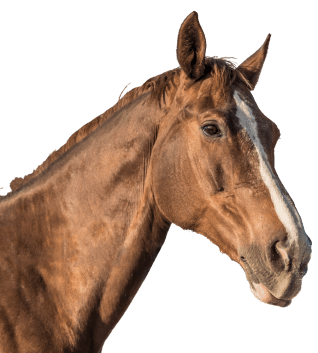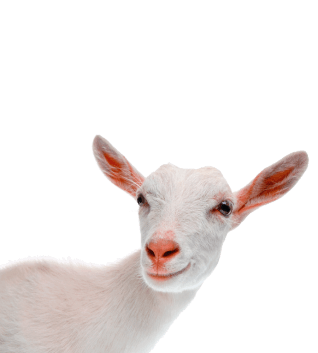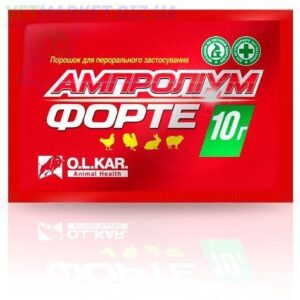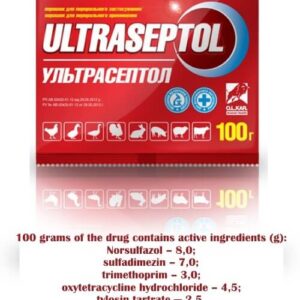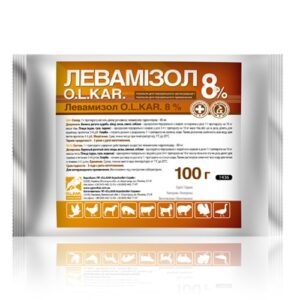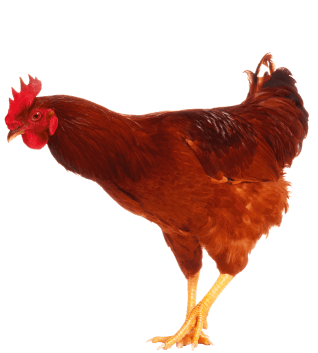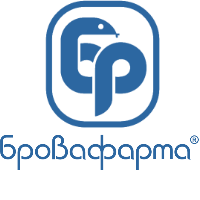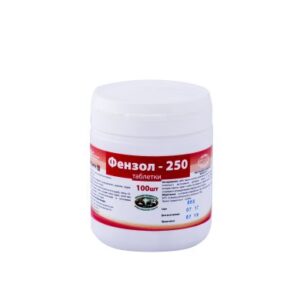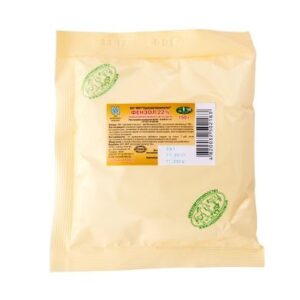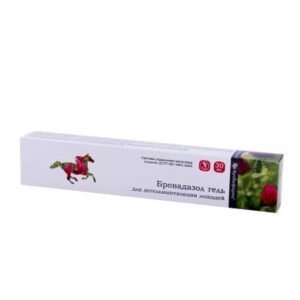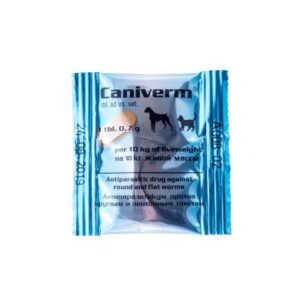Brovadazol PLUS (piperazine adipinate, fenbendazole) powder for oral use, 100g
1 g of the drug contains:
piperazine adipinate – 250 mg
fenbendazole – 30 mg
Description
White powder, non-volatile, non-hygroscopic, odorless, insoluble in water.
Pharmacological properties
Fenbendazole belongs to the group of benzimidazoles. Destroys the microtubules of digestive cells and causes a neurotoxic effect in helminths. It has a detrimental effect on the larvae of various stages and disrupts the integrity of the helminth egg shells, after which they are unable to develop further.
When administered orally, the maximum concentration of fenbendazole in blood plasma is reached after 0.5-7 hours. It is weakly bound to plasma proteins, transformed into inactive metabolites by decarboxylation. The half-life is 2.8-9 hours. Most of the substance is excreted unchanged and as metabolites in the feces, about 1% – in the urine. The resorbed drug accumulates mainly in the liver and adipose tissue. About 40% of the drug that enters the lumen of the small intestine with bile is reabsorbed, which prolongs its contact with intestinal parasites. In the body it is converted into fenbendazole and oxfendazole, as well as other metabolites.
Piperazine is a synthetic anthelmintic drug with a narrow spectrum of action, which paralyzes the muscular apparatus of helminths. Only some nematodes are susceptible to it, and the most sensitive roundworms and pinworms. Piperazine does not give high concentrations in body tissues, acts exclusively in the intestinal lumen and does not kill parasites, but only paralyzes their muscles. This avoids the danger of absorption of toxic products of helminth decay.
Piperazine crosses the placental barrier and enters the milk of the animal. It is metabolized in the liver to form inactive metabolites. Excreted by the kidneys, complete excretion of metabolites occurs within 24 hours, in hepatic and renal failure, this process may take longer.
The combination of fenbendazole and piperazine adipinate enhances the effect of the drug against pathogens of the family Ascaridae.
Method of application and dosage
Before use, the drug is mixed with food and given during morning feeding individually or in groups.
Before group deworming, each batch of the drug is pre-tested on a small number of animals, which are observed during the day. In the absence of complications, you can carry out mass deworming.
With the group method of treatment, the total amount of the drug is increased by 5%.
Doses of the drug for different species of animals and the course of application are listed in the table.
| Animal species and diseases | Dose, g / 10 kg of body weight | Course of application |
| Pigs: | ||
| ascariasis, trichurosis, esophagostomosis, metastrongylosis, strongyloidiasis, hyostrongylosis | 1.5 | 2 days |
| olulanosis, physocephaly | 3 | |
| Piglets aged 1-4 months: | ||
| prevention | 0.4-0.5 | Once a week |
| Horses: | ||
| parascarosis, oxyurosis, strongylatosis, cyatostomidosis, strongyloidiasis | 1.5-2 | once |
| Foals aged 1-6 months: | ||
| mixed invasion | one | 2 days |
| Carnivorous and fur animals: | ||
| ankylostomosis, strongyloidiasis, toxocariasis, toxascarosis, uncinariosis | 8-10 | 3 days |
| Rabbits: | ||
| passalurosis, protostrongylosis, trichostrongylosis, trichocephaly | five | once |
| Chickens: | ||
| ascariasis, heterakidosis, capillariosis | 1.5 | 2 days |
| syngamosis | 2 | |
| Waterfowl: | ||
| amidostomosis, heteracosis (syn. ganguleteracosis), singamosis, tetramerosis | 2-2.5 | 2 days |
| hymenolepidosis, notocotylidosis | 7.5-8 | |
*Kilograms to a Pounds conversion table
| Kilograms (kg) | Pounds (lb) | Pounds+Ounces (lb+oz) |
| 0.1 kg | 0.220 lb | 0 lb 3.527 oz |
| 1 kg | 2.205 lb | 2 lb 3.274 oz |
| 5 kg | 11.023 lb | 11 lb 0.370 oz |
| 10 kg | 22.046 lb | 22 lb 0.740 oz |
Reservation
After the last application of the drug, slaughter of animals and poultry for meat is allowed after 7 days. The use of internal organs (liver, lungs, heart) in food is allowed after 10 days. Meat obtained before this date is disposed of or fed to non-productive animals, depending on the conclusion of the veterinarian.
Indication
Treatment and prevention of animals with helminthiasis:
- pigs – gastrointestinal tract caused by mature nematodes and larvae of stage 4 Ascaris suum, Oesophagostomum dentatum, mature Strongyloides ransomi, Trichuris suis, Hyostrongylus rubidus, Ollulanus spp., Physocephalus scxalatus and lung;
- horses – gastrointestinal tract caused by nematodes Parascaris equorum, Oxyuris equi, Strongylidae tribus, Cyathostomidae tribus, Strongyloides westeri;
- carnivorous animals (dogs, foxes, polar foxes) – gastrointestinal tract caused by nematodes Ancylostoma caninum, Uncinaria stenocephala, Toxocara canis, Toxascaris leoninae, Strongyloides srr .;
- rabbits – caused by nematodes Passalurus ambiguous, Trichostrongylidae gen., Protostrongylus commatatus, Trichuris leporis;
- poultry (chickens, turkeys, parrots, quails, pheasants) – caused by nematodes Ascaridia galli, Heterakis gallinarum, Heterakis isoloche, Capillaria anseris, Syngamus trachea, Tetrameres spp .;
- waterfowl (geese, ducks) – caused by nematodes Amidoslomum anseris, Heterakis dispar (syn. Ganguloterakis dispar), Syngamus skrjabinomorpha, Tetrameres fissispina, cestodes Hymenolepis srr., Fimbriaria fasciolacys, trematodes.
Contraindication
Do not prescribe to sows two weeks before farrowing.
Do not use with alkalis, oxidizers and iodine-containing drugs!
Storage conditions
In a dry, dark place at a temperature up to +25 ° C.
Expiration date
3 years.




